belt JEEP WRANGLER 2006 TJ / 2.G Owner's Manual
[x] Cancel search | Manufacturer: JEEP, Model Year: 2006, Model line: WRANGLER, Model: JEEP WRANGLER 2006 TJ / 2.GPages: 368, PDF Size: 14.3 MB
Page 42 of 368

Installing Child Restraints Using the Vehicle Seat
Belt
The passenger seat belts are equipped with cinching latch
plates, which are designed to keep the lap portion tight
around the child restraint so that it is not necessary to use
a locking clip. Pull up on the shoulder portion of the
lap/shoulder belt to tighten the belt. The cinching latch
plate will keep the belt tight, however, any seat belt
system will loosen with time, so check the belt occasion-
ally and pull it tight if necessary.
In the rear seat, you may have trouble tightening the
lap/shoulder belt on the child restraint because the
buckle or latch plate is too close to the belt path opening
on the restraint. Disconnect the latch plate from the
buckle and twist the short buckle-end belt several times
to shorten it. Insert the latch plate into the buckle with the
release button facing out. If the belt still cannot be tightened, or if by pulling and
pushing on the restraint loosens the belt, you may need
to do something more. Disconnect the latch plate from
the buckle, turn the buckle around, and insert the latch
plate into the buckle again. If you still can’t make the
child restraint secure, try a different seating position.
To attach a child restraint tether strap:
For the rear outboard seating positions, route the tether
over the rear seat and attach to the rear floor tether
anchors. If the Add-A-Trunk™ option is present in the
vehicle, the lid should be opened and positioned against
the back of the rear seat prior to attaching and adjusting
the strap.
42 THINGS TO KNOW BEFORE STARTING YOUR VEHICLE
Page 43 of 368
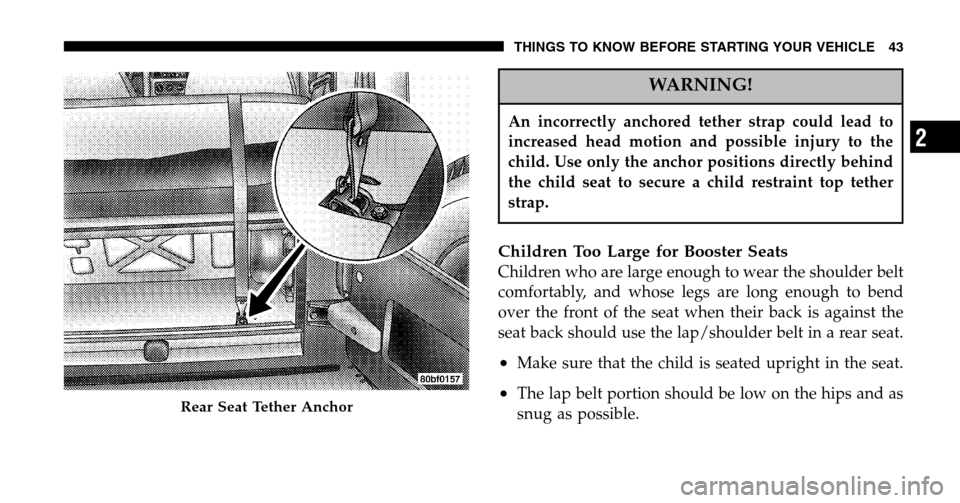
WARNING!
An incorrectly anchored tether strap could lead to
increased head motion and possible injury to the
child. Use only the anchor positions directly behind
the child seat to secure a child restraint top tether
strap.
Children Too Large for Booster Seats
Children who are large enough to wear the shoulder belt
comfortably, and whose legs are long enough to bend
over the front of the seat when their back is against the
seat back should use the lap/shoulder belt in a rear seat.
•Make sure that the child is seated upright in the seat.
•The lap belt portion should be low on the hips and as
snug as possible.Rear Seat Tether Anchor
THINGS TO KNOW BEFORE STARTING YOUR VEHICLE 43
2
Page 44 of 368

•Check belt fit periodically. A child’s squirming or
slouching can move the belt out of position.
•If the shoulder belt contacts the child’s face or neck,
move the child closer to the center of the vehicle.
Never allow a child to put the shoulder belt under an
arm or behind their back.
Transporting Pets
Airbags deploying in the front seat could harm your pet.
An unrestrained pet will be thrown about and possibly
injured, or injure a passenger during panic braking or in
a collision.
Pets should be restrained in the rear seat in pet harnesses
or pet carriers that are secured by seat belts.
ENGINE BREAK-IN RECOMMENDATIONS
A long break-in period is not required for the engine in
your new vehicle.
Drive moderately during the first 300 miles (500 km).
After the initial 60 miles (100 km), speeds up to 50 or 55
mph (80 or 90 km/h) are desirable.
While cruising, brief full-throttle acceleration, within the
limits of local traffic laws, contributes to a good break-in.
Wide open throttle acceleration in low gear can be
detrimental and should be avoided.
The engine oil installed in the engine at the factory is a
high quality energy conserving type lubricant. Oil
changes should be consistent with anticipated climate
conditions under which vehicle operations will occur.
The recommended viscosity and quality grades are
shown in Section 7 of this manual. NON-DETERGENT
OR STRAIGHT MINERAL OILS MUST NEVER BE
USED.
44 THINGS TO KNOW BEFORE STARTING YOUR VEHICLE
Page 46 of 368

•On hardtop models, keep the tailgate window closed
when driving your vehicle. On fabric top models, do
not drive with the rear window curtain up unless the
side curtains are also open. This will prevent carbon
monoxide and other poisonous exhaust gases from
entering the vehicle.
Safety Checks You Should Make Inside The
Vehicle
Seat Belts
Inspect the belt system periodically, checking for cuts,
frays and loose parts. Damaged parts must be replaced
immediately. Do not disassemble or modify the system.
Seat belt assemblies must be replaced after an accident if
they have been damaged (bent retractor, torn webbing,
etc.). If there is any question regarding belt or retractor
condition, replace the belt.
Airbag Warning Light
The light should come on and remain on for 6 to 8
seconds as a indicator check when the ignition switch is
first turned on. If the indicator is not lit during starting,
have it serviced. If the light stays on or comes on while
driving, have the system checked by an authorized
dealer.
Defrosters
Check operation by selecting the defrost mode and place
the blower control on high speed. You should feel the air
directed against the windshield.
46 THINGS TO KNOW BEFORE STARTING YOUR VEHICLE
Page 57 of 368
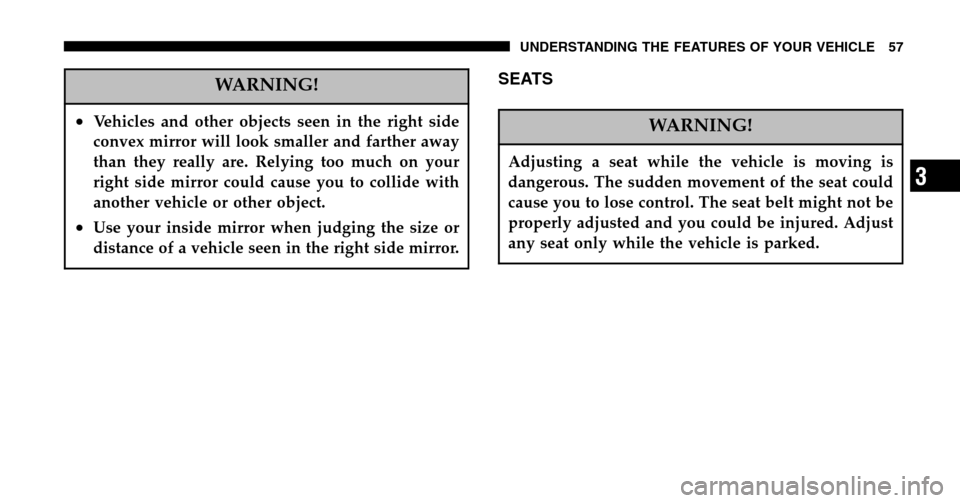
WARNING!
•Vehicles and other objects seen in the right side
convex mirror will look smaller and farther away
than they really are. Relying too much on your
right side mirror could cause you to collide with
another vehicle or other object.
•Use your inside mirror when judging the size or
distance of a vehicle seen in the right side mirror.
SEATS
WARNING!
Adjusting a seat while the vehicle is moving is
dangerous. The sudden movement of the seat could
cause you to lose control. The seat belt might not be
properly adjusted and you could be injured. Adjust
any seat only while the vehicle is parked.
UNDERSTANDING THE FEATURES OF YOUR VEHICLE 57
3
Page 59 of 368
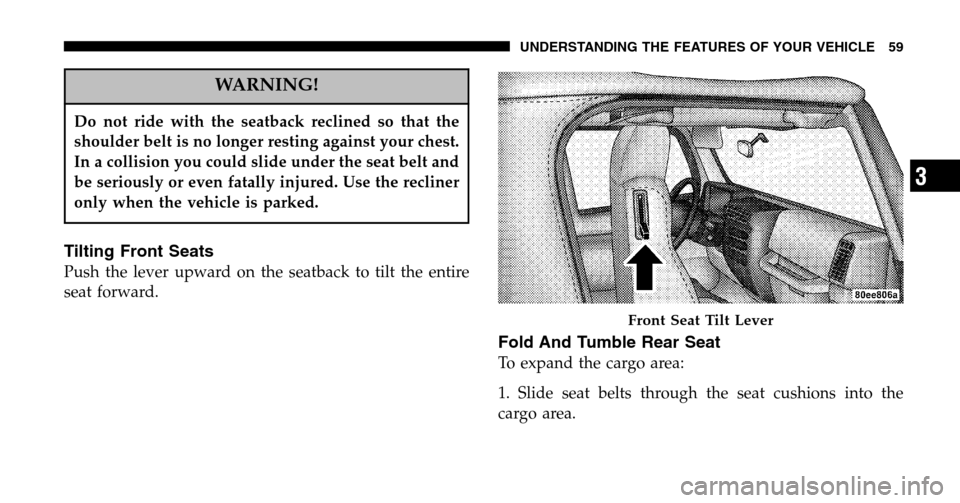
WARNING!
Do not ride with the seatback reclined so that the
shoulder belt is no longer resting against your chest.
In a collision you could slide under the seat belt and
be seriously or even fatally injured. Use the recliner
only when the vehicle is parked.
Tilting Front Seats
Push the lever upward on the seatback to tilt the entire
seat forward.
Fold And Tumble Rear Seat
To expand the cargo area:
1. Slide seat belts through the seat cushions into the
cargo area.
Front Seat Tilt Lever
UNDERSTANDING THE FEATURES OF YOUR VEHICLE 59
3
Page 61 of 368
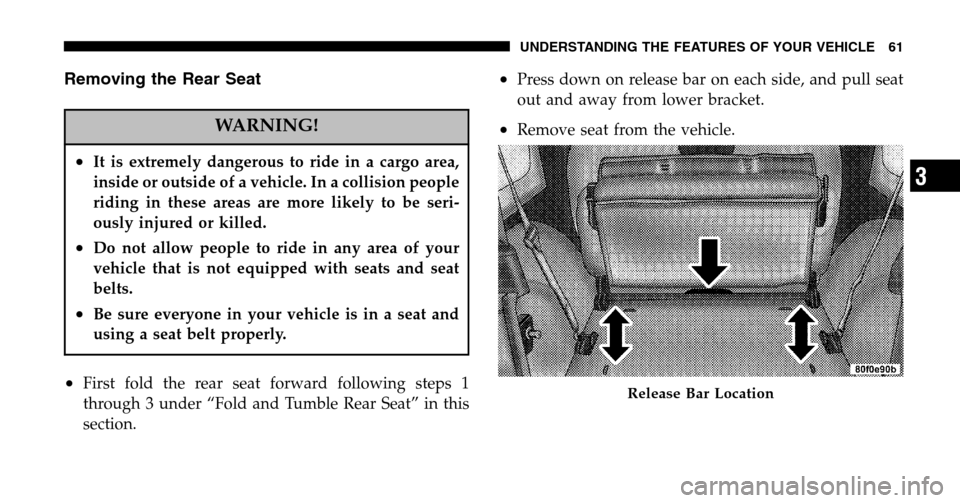
Removing the Rear Seat
WARNING!
•It is extremely dangerous to ride in a cargo area,
inside or outside of a vehicle. In a collision people
riding in these areas are more likely to be seri-
ously injured or killed.
•Do not allow people to ride in any area of your
vehicle that is not equipped with seats and seat
belts.
•Be sure everyone in your vehicle is in a seat and
using a seat belt properly.
•First fold the rear seat forward following steps 1
through 3 under “Fold and Tumble Rear Seat” in this
section.
•Press down on release bar on each side, and pull seat
out and away from lower bracket.
•Remove seat from the vehicle.
Release Bar Location
UNDERSTANDING THE FEATURES OF YOUR VEHICLE 61
3
Page 62 of 368
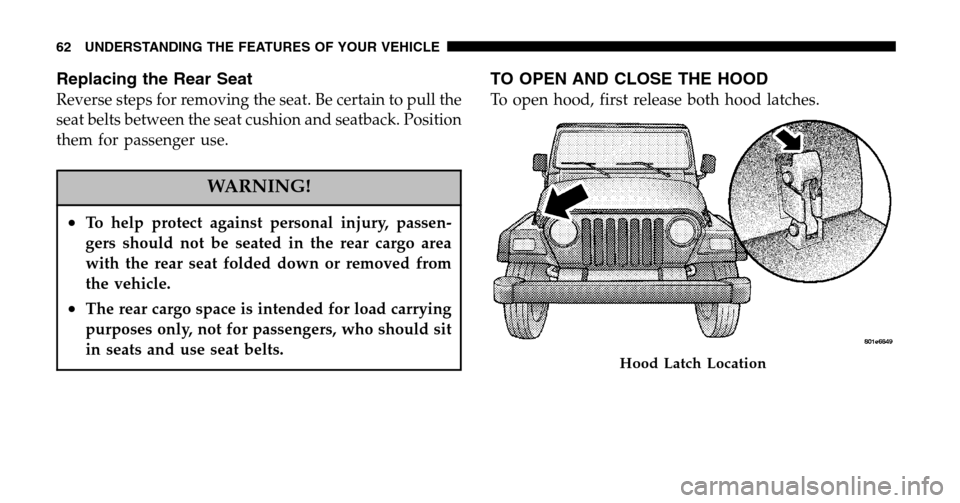
Replacing the Rear Seat
Reverse steps for removing the seat. Be certain to pull the
seat belts between the seat cushion and seatback. Position
them for passenger use.
WARNING!
•To help protect against personal injury, passen-
gers should not be seated in the rear cargo area
with the rear seat folded down or removed from
the vehicle.
•The rear cargo space is intended for load carrying
purposes only, not for passengers, who should sit
in seats and use seat belts.
TO OPEN AND CLOSE THE HOOD
To open hood, first release both hood latches.
Hood Latch Location
62 UNDERSTANDING THE FEATURES OF YOUR VEHICLE
Page 91 of 368

CAUTION!
When removing the 2 front screws just rearward of
the doors, make sure that the nut does not fall into
the seat belt retractor. Grasp the nut to prevent this
from occurring.
NOTE: On a dual top vehicle, the two rear and center
nuts are retained onto the bodyside.
4. Open both doors.
5. Open tailgate all the way to ensure clearance of the
rear window glass. Lift rear window glass.
UNDERSTANDING THE FEATURES OF YOUR VEHICLE 91
3
Page 96 of 368
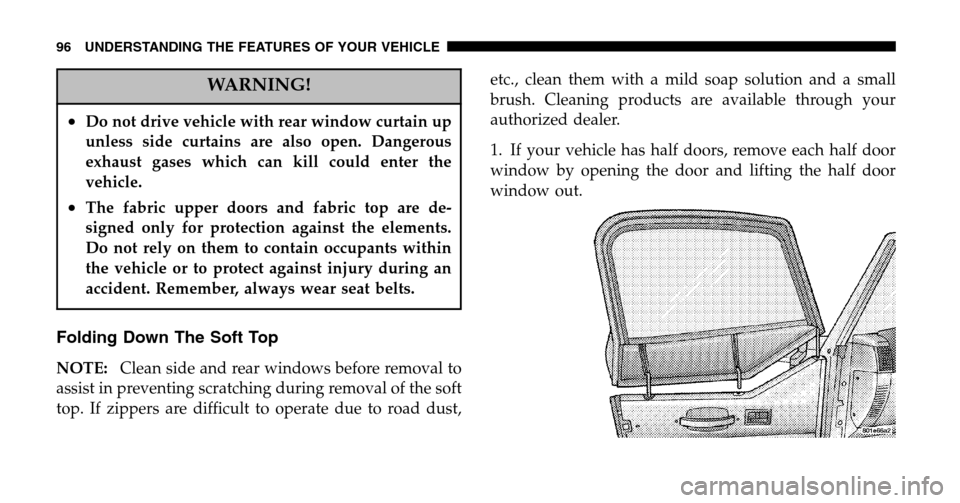
WARNING!
•Do not drive vehicle with rear window curtain up
unless side curtains are also open. Dangerous
exhaust gases which can kill could enter the
vehicle.
•The fabric upper doors and fabric top are de-
signed only for protection against the elements.
Do not rely on them to contain occupants within
the vehicle or to protect against injury during an
accident. Remember, always wear seat belts.
Folding Down The Soft Top
NOTE: Clean side and rear windows before removal to
assist in preventing scratching during removal of the soft
top. If zippers are difficult to operate due to road dust, etc., clean them with a mild soap solution and a small
brush. Cleaning products are available through your
authorized dealer.
1. If your vehicle has half doors, remove each half door
window by opening the door and lifting the half door
window out.
96 UNDERSTANDING THE FEATURES OF YOUR VEHICLE